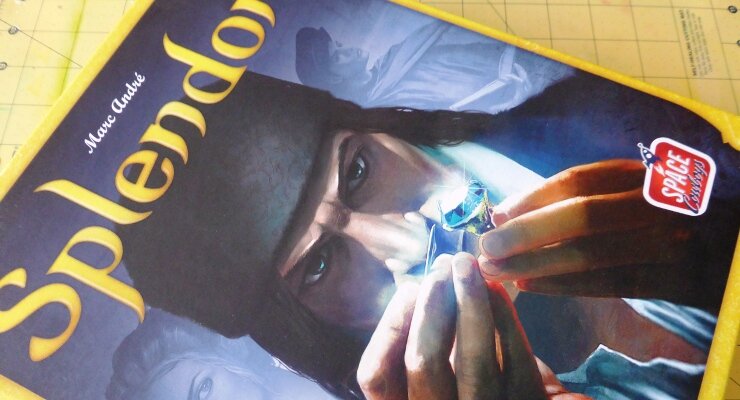
I raved about high quality of game components for Splendor the Board Game. But how does it actually play? Splendor is described as a chip collecting and card development game. This is actually a good, very literal summary of the two main steps that make up this game.
| Year Published | 2014 |
| Number of Players | 2 − 4 |
| Suggested Ages | 10 and up |
| Playing Time | 30 minutes |
#1 – Setting Up a Game of Splendor

Above is the basic set-up of cards for Splendor: 3 rows of 4 cards, ranging from the lowest (green back), which are the cheapest to buy, to the highest and most expensive (blue back).
Example:
The right-most cards in this set-up are all cards that award a blue gem.
The card in the lowest row is the easiest to buy (1 white chip, 2 green chips, 2 red chips), but awards no points. The card in the middle row can only be purchased with 5 blue gemstone-chips, but awards 2 points in addition to a further blue gem. Finally, the right-most card in the top row is very expensive, but awards 3 points, as well as a blue gem.
Aside from the cards, the set-up will also include the noble-tiles (one for each player +1) and the chips themselves (fewer with fewer players).
#2 – Buying Cards

The core of the game is to use the gemstone chips to buy up cards, and be the first player to get 15 points.
How do you get gem-stone chips? Well, they are drawn each turn. On a turn, a player usually has the following options.
- Draw 3 gemstone chips of different colours.
- Draw 2 gemstone chips of the same colour, provided there are more than 4 left.
- Draw 1 single, golden gold-joker chip and reserve a card.
- Buy a card from the table (or the reserve) with chips from previous turns.
This way, players take turns collecting chips, and in turn buy cards. I found that there is usually a good bit of competition, as there aren’t that many chips in the game (individual colours are often “sold out” during the game). The gold-jokers (which can be used as any colour) help a bit. Also, a player can never have more than 10 chips at any given time.
The trick of the game, and how players are able to afford higher-point-value-cards, is the fact that the cards you already own give a discount for the purchase of future cards!
It is also the reason why it makes sense to by “zero-point-value”-cards.

For example, the player above collected these 7 cards. They only amount to a total of 3 victory points, still a long way to go to get 15. However, said player would get a discount of 1 blue, 3 green and 3 black from each future card he or she buys.
To purchase the rather pricey white card below, said player would “only” need to get 2 blue chips and 5 red chips.

Though basic price of this card is 3 blue, 3 green, 5 red and 3 black.
With 3 green and 3 black cards in the player’s deck already, these are discounted to zero. One blue card reduced the price from 3 blue to 2 blue. However, the above player has no red cards in his deck, so he or she still needs to pay the full price.
This white card is worth 3 victory points.
That, in a nutshell, is the core of the game: collect chips and buy cards, starting with “cheap” cards to build up discounts, and later the pricier, high-value cards, racing to 15 points.
#3 – The Visiting Nobles

The last element to the game are the nobles, or patrons, which grant extra points for collecting specific colours.
With the two nobles shown above, the left-hand one would “visit” (granting 3 extra points) to the first player who collects 3 black, 3 red and 3 green gem-cards. The example player shown is still missing a black one for that.
The right-hand one would visit the first player with 3 green, 3 blue and 3 red. The example player above qualifies for that, and with the 3 extra points, would have a total of 15 victory points and possibly win the game.
One thing unclear is the rules, unclear to me, is whether “visiting nobles” stay with a given player, or return to the general area after a “visit”, assuming the game hasn’t ended. Could a second player receive a visit from the same noble at a later turn?
Questions aside, the main purpose of these nobles, obviously, is to shake up the game, add competition and replay value. If both of these nobles were in play in a given game, there would likely be fierce competition over green and red cards.
#4 – Thoughts?
That is the game play overview for Splendor so far. A more detailed review coming up.
Leave a comment and let me know what you think!
Z.







